PONIES OF CAL ELEC WORKS
Reprinted from "Crown Jewels of the Wire", July 2006, page 30
Here's an interesting observation about insulators and insulator
collecting. The more I learn about the subject, the more I realize how little I
actually know. The CD 120 pony insulators manufactured for California Electric
Works are a perfect illustration. Please enjoy this article... out of curiosity
if nothing else. Howard Banks
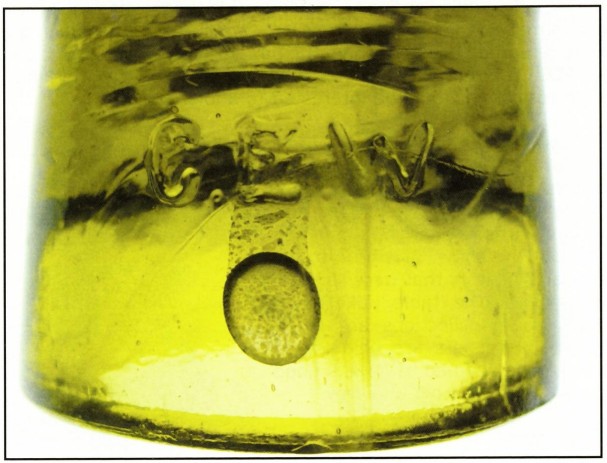
While I suspected there were more mold varieties than just the two embossed
and one unembossed styles listed in the Price Guide, I was surprised at what I
discovered once I started looking closely at them.
But before talking in some detail about the insulators. let's put the CEW
ponies in historical perspective.
HISTORY
The Electrical Construction & Maintenance Company of San Francisco was
the first supplier of telegraph equipment on the West Coast to have insulators
manufactured with its name on them. The company was founded late in 1870, and
aggressively constructed hundred of miles of telegraph line in the next few
years. Perhaps tens of thousands of insulators embossed EC&M Co SF, in CD
style 123, were produced and placed in service. By June of 1877, the company was
re-organized and a new company called California Electrical Works was formed in
its place.(1)
It's apparent from advertising that the new company continued to use CD 123
EC&M's for several years. A telegraph line constructed in association with
the Nevada Central Railway used CD 123 EC&M's exclusively. Construction of
the railroad was begun in 1878 and completed in early 1880.(2)
But most likely by the mid-1880's, California Electrical Works was using
insulators made specifically for them. CD 130 and CD 130.1 styles are embossed
CAL ELEC WORKS / PATENT. The "PATENT' wording is likely a reference to
company superintendent Paul Seiler's own insulator design patented in 1877, the
CD 130.2.
When were CD 120 ponies put into service? Being a smaller insulator, were
they designed for telephone lines? How do we know "C.E.W." stands for
California Electrical Works?
Hmm. Patent dates of 1871 and 1883 are found on older CD 120 ponies. The 1871
date is the Hemingray patent for "moulding glass telegraph
insulators". The 1883 patent date placed on CD 120's manufactured for Homer
Brooke's refers to a method of "forming threads", and not to the
design of the insulator.(3) Nevertheless, Hemingray made CD 120's well before
the company patented drip points in 1893. Therefore, it seems reasonable to
believe CD 120 ponies came into their own in the mid-to-late 1880's.
Circumstantial evidence connects "C.E.W." with "Cal Elec
Works". The ponies were found largely in California, western Nevada or
Southern Oregon. Early collectors frequently found CD 120 C.E.W.'s as replacement
insulators for CD 123 EC&M's. That, in turn, indicates they were used on
telegraph lines as well as telephone lines. EC&M replacements? That's where
this survey gets interesting.
MOLD COMPARISONS
Ever look at the top of a pin hole in an EC&M? Notice the bead of glass
that hangs down? Did you know that there are CEW ponies will a similar bead at
the top of the pin hole?
What I noticed first is that the pin hole in some CEW's is much smaller in
diameter, just like the substandard size for EC&M insulators. You can tell
instantly if you have one. Stick your thumb in the pin hole. On the undersized
pin style you can practically get your thumb stuck.
Is it possible that these were deliberately made as EC&M replacements? I
have two in my collection. Both are aqua. One is embossed C.E.W. and the other is
unembossed. Both were made in three piece molds. Both were made for an
undersized pin. And both have a bead of glass at the top of the pin hole.
I'd like to hear from other collectors who have these varieties. What color
is the glass? Embossed or Unembossed? With the bead of glass at the top, were
these made by a different manufacturer than the other three piece molds? Does
anyone have a MLOD variety in the substandard pin size?
(For information on mold varieties, turn to page 43.)
(page 31)
CEW GALLERY
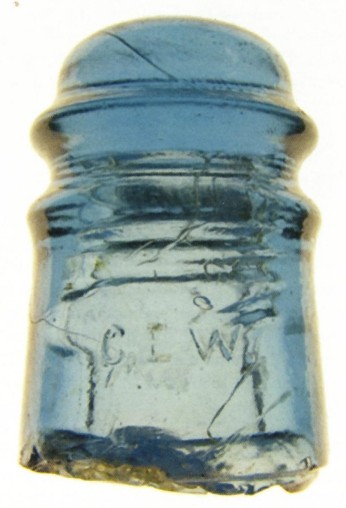
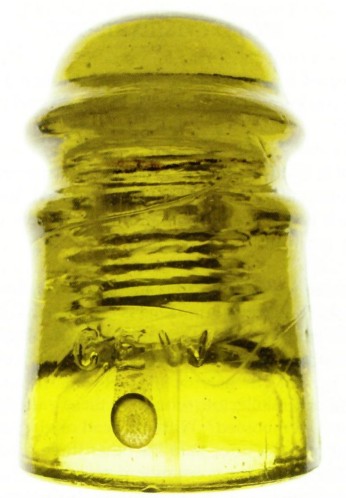
(page 32)
SOME OF THE FINEST KNOWN
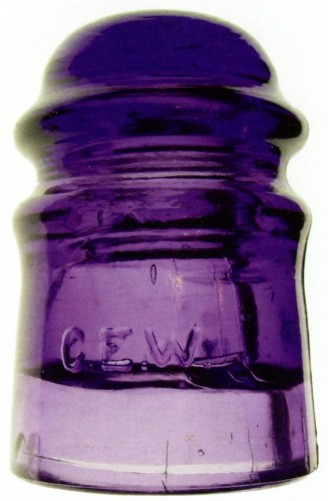
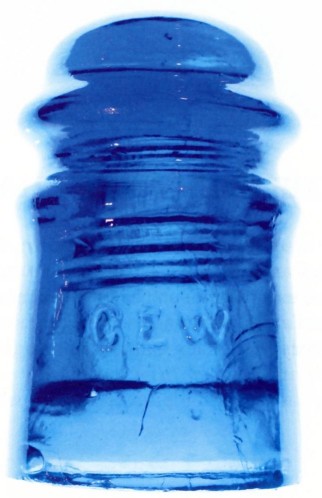
(page 33)
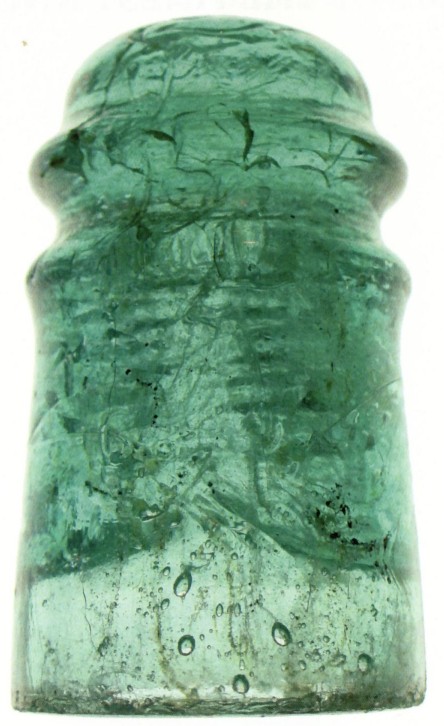
YES, SOME EVEN HAVE CHARACTER
CEW ponies are not particularly well known for" character". Most
examples are rather consistent in the clarity of the glass. There are some
exceptions, such as the specimen shown above. We've enlarged the image so you
can better enjoy everything that's going on in the glass.
(page 34)
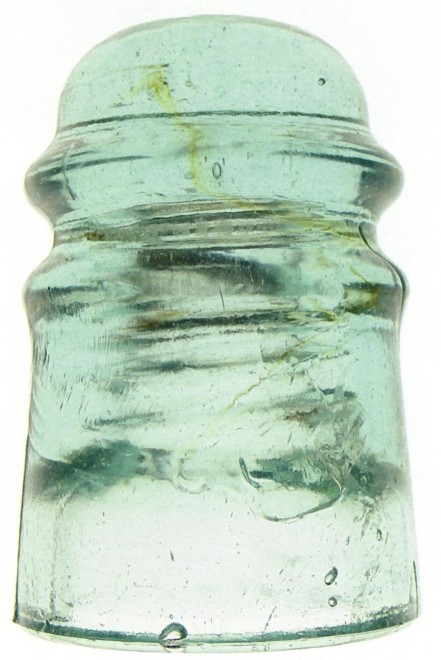
MILKY, CLOUDY OR HAZY?
A small group of CEW ponies have been found that appear to have been produced
from an unusual batch of glass. We hesitate to call them "milky", as
they don't have curtains of milk like some Hemingrays. "Cloudy" would
seem to indicate distinct areas of discoloration. Perhaps "hazy" is a
better term, as the overall appearance is affected, as the sky might be on a
"hazy day".
(page 35)
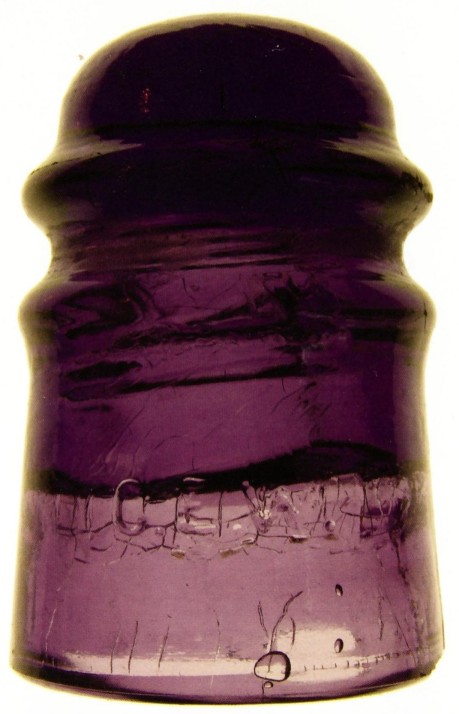
PROVENANCE
Provenance: Noun, meaning "origin; derivation; source". From the
Latin word provenire meaning "to come forth".*
Embossed CEW's in purple are among the hobby's scarcest insulators. You
wouldn't run out of fingers on your two hands in counting them. When something's
that rare, it's nice to know the history, or origin, of the piece. The story for
the particular example shown above is that it was removed from a tree by a
collector who was a park ranger at Yosemite National Park. He sold it many years
ago to a collector who didn't part with it until just this spring. Known to the
hobby for nearly forty years, this insulator has had just three owners since the
line when out of service.
(page 36)
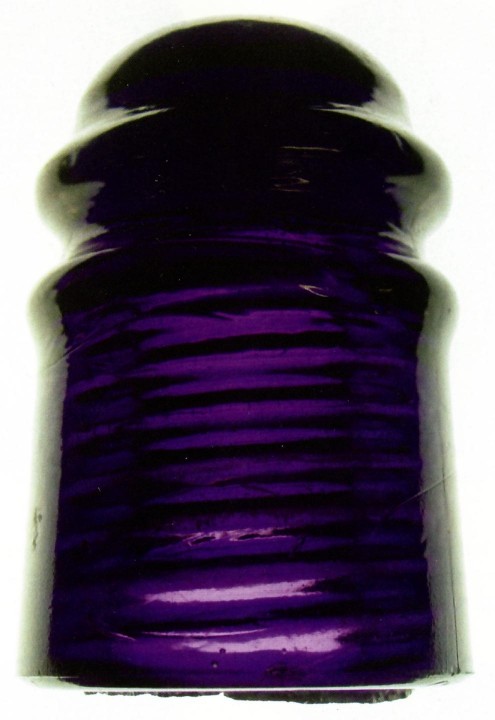
PLUM PRETTY
The provenance of this dark, dark purple unembossed CEW is even better
documented than the insulator on the opposite page. According to his
granddaughter, Arthur S. Bell (1895 - 1973) removed it from service himself
during a life-long career working at hydro-electric projects in California. She
remembers that hundreds of insulators covered the roof of her granddad's house.
Because her favorite color was purple, Grandpa Bill gave her this pretty pony.
He worked for Southern California Edison at the time she received this
insulator. However, earlier in his career, Arthur Bell worked at the Big Creek
Hydro-electric Complex in the mountains northeast of Fresno.(4) That's just
south of Yosemite, where the insulator on page 36 was found.
(page 37)
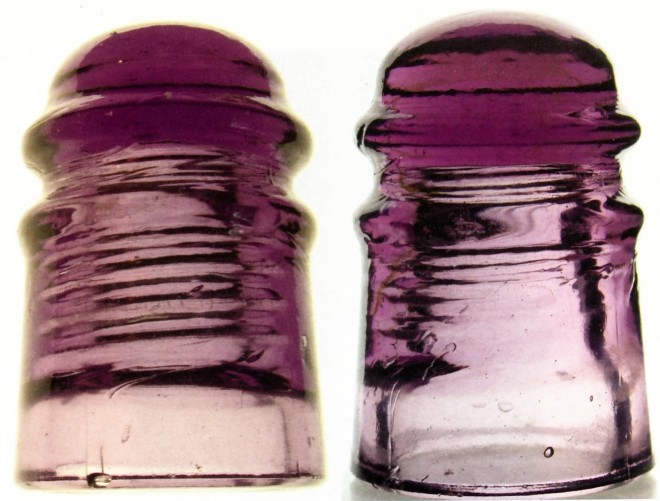
Variations on a Theme
Shown here are four unembossed CEW's with varying intensities of purple
coloration.
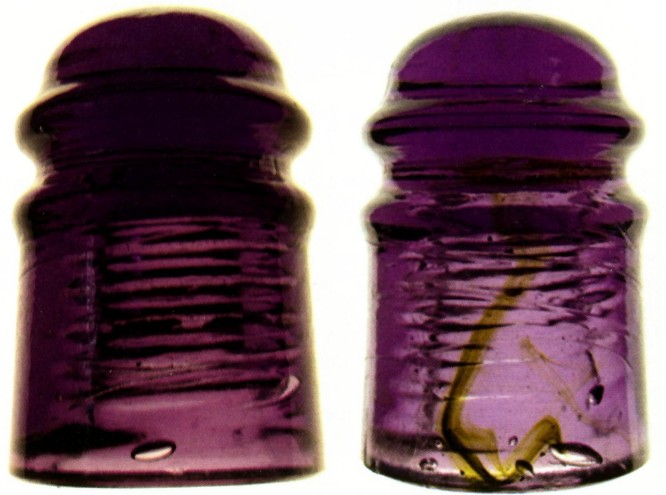
(page 38)
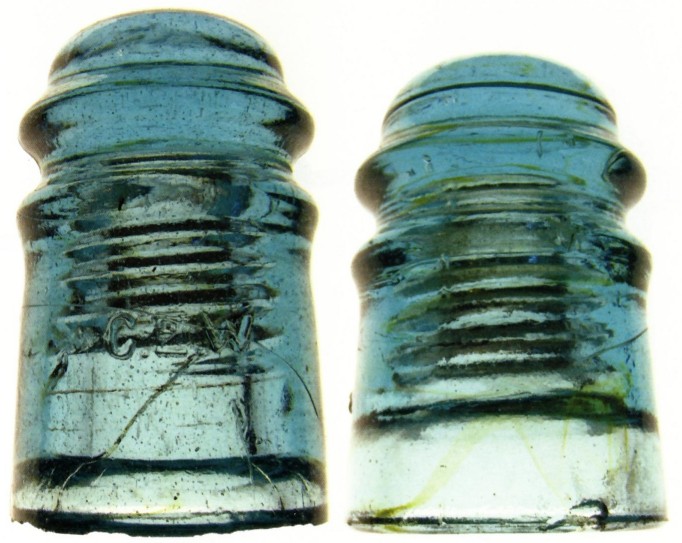
Upper Left: "Tall" embossed CEW
Upper Right: Embossed CEW with
undersized pin hole.
Lower Left: Unembossed CEW in straw, with light amber
swirls.
Lower Right: Unembossed CEW in aqua; rarer than purple.
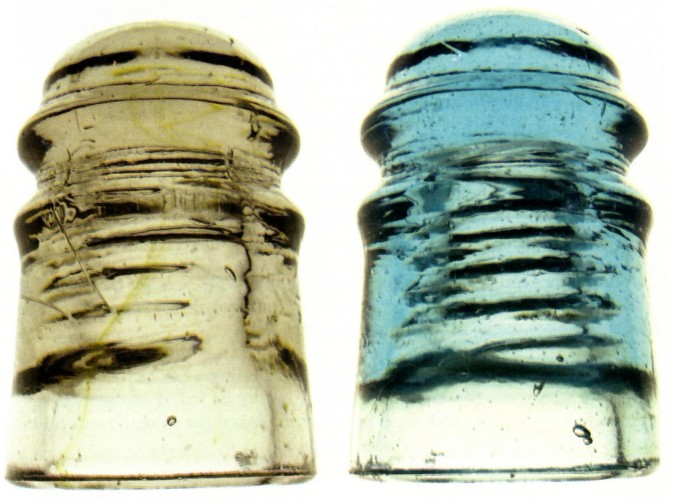
(page 39)
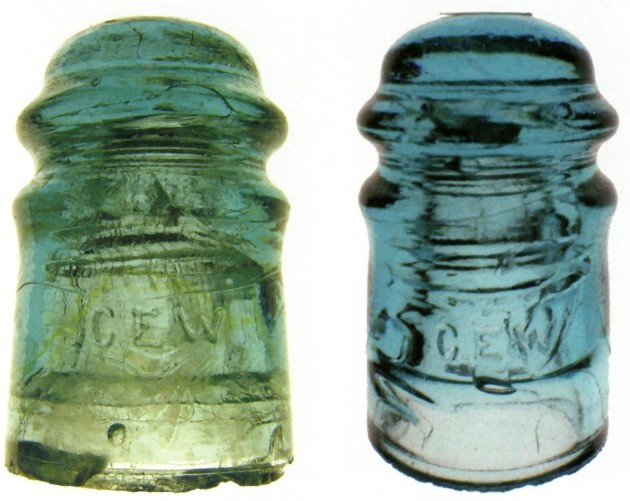
GREAT BUYS
Perhaps because CEW's can be rather ordinary looking, some great buys are
made occasionally. Why scanning garage sale ads, I once read of a sale that
featured "old bottles". Well, if they have old bottles, I told myself,
they might just have a couple of insulators. I was wrong. They only had one. It
was the CEW shown on the left above. When I asked where he got it, the owner
pointed to a giant, old tree in front of his house. He said he took it off the
clearly visible side peg himself. The insulator is damaged, but is also full of
milk and steam. I paid the man's asking price: $2. Alas, I didn't find any more
side pegs in trees along the man's street.
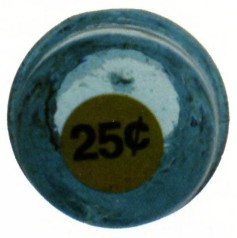
Janet Bond once did better than that. Just a couple years ago, she purchased
the aqua, embossed, CEW shown above at a garage sale for 25-cents. She
says she doesn't have the heart to remove the price tag.
Mid Norris reports attending a garage sale and finding a box of purple
bottles for sale for $2 apiece. Searching through the bottles he found an
unembossed, purple CEW at the bottom of the box. When he asked the price, he was
told it was the same as the bottles. Yep. He bought it.
(page 40)
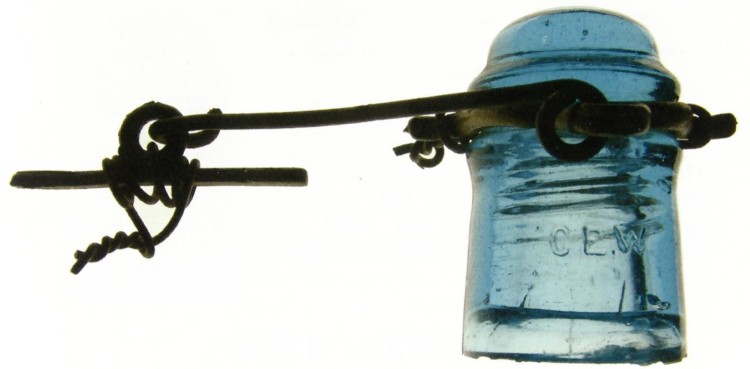
CEW YOKES
CD 120 CEW insulators were used on some of the early telegraph and telephone
lines that ran through the heavily timbered Sierra Nevada mountains. Imagine
what might happen to the insulators and side pins if a tree top or large limb
came crashing down through the telephone wire.
To reduce maintenance requirements of lines through timber country, special
harnesses were developed for the insulators. The wire was actually suspended
from an extension that was connected to a yoke that was connected to the
insulator. A short metal rod (left above) was tied to the telephone wire to help
keep it aligned. The telephone line, then, was less rigid. Now if a tree or tree
limb fell into the phone wire, there would be enough "play" in the
line to, hopefully, keep the wire, or insulator, or bracket from breaking.
Service outages were fewer, and maintenance costs less.
The concept was well known to the telegraph industry in the 1850's. A line
built in the timber country from Weaverville to Yreka, California in 1858 used
the rubber Goodyear "threadless hats" affixed with similar harnesses.
(See page 19 of the January 2002 issue of Crown Jewels for a photo.)
Yokes are found made from hand-forged steel, or as in the example above, from
brass. Insulators with original yokes and harnesses are somewhat scarce.
Collectors in the early days of the hobby were generally after the glass, and
many paid little or no attention to the hardware. Later, collectors removed
everything, including the side pegs. CEW sidepegs are especially attractive,
dating as they do from the time period when square nails were in use.
(page 41)
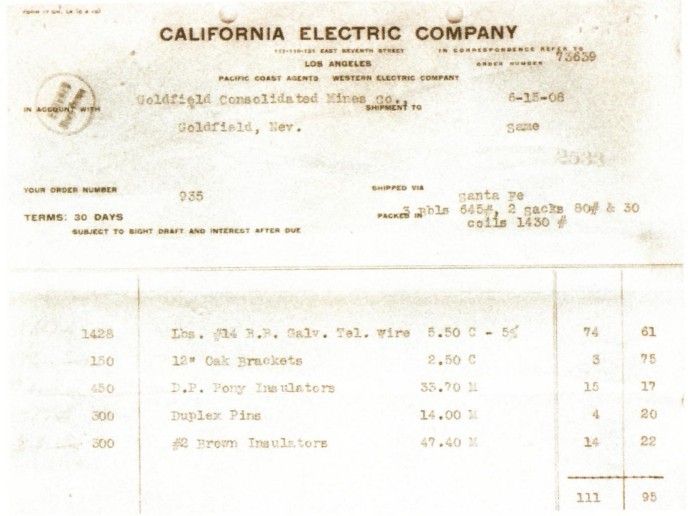
ORDER FOR 450 PONY INSULATORS
Whoa. Don't pack the car and head for Goldfield, Nevada hoping to find 450
CEW ponies. By the time this order was placed (1908), Cal Elec Works had changed
names to California Electric Company; the firm was now a division of Western
Electric; offices had been moved to Los Angeles; and those insulators had drip
points ("D.P. Pony Insulators"). By the turn of the century California
Electric was selling Hemingray products. However, those 300 #2 Brown Insulators
used with duplex pins were CD 187's. Now, they could be worth looking for. But
being sold to a mining company, they could have all been used underground.
TALL CEW's
Like many insulators made in the late 1800's, including CD 123 EC&M's and
CD 130 Cal Elec Works, the height of an insulator depends upon how much glass
was placed in the mold. Collectors have been know to pay premium prices for
exceptionally tall CEW ponies. The example shown on page 39 would only be
considered moderately taller.
The difference in height can be visually quite distinct and striking. But
when measured, the difference in height is usually only 1/4 to 1/2 inch. CEW
ponies are typically 3 and 3/8th inches tall. The one on page 39 is 3 and
5/8ths inches tall. Examples this size are not that scarce. Before paying a
significant premium, look for one at least 3 and 7/8th inches high.
(page 42)
|
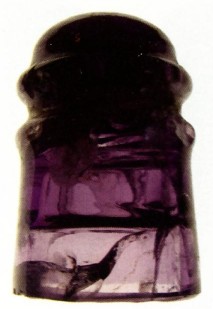
|
|
Fractured. |
|
|
|
|
|
Chipped. |
|
|
|
|
|
Damaged. |
|
|
|
|
|
Broken. |
|
|
|
|
|
Busted! |
|
|
|
|
|
|
Not sure which term best describes this insulator. But with all that
"character" this piece was purchased at a recent national show for the
grand price of $5. |
|
MOLD VARIETIES
McDougald's Price Guide (5) lists the following mold styles and color
varieties for CD 120 CEW ponies:
EMBOSSED: "C.E.W."
[010] Three piece mold. Found in aqua, blue, ice aqua, light green aqua,
cornflower blue, olive green, purple, cobalt blue & mustard yellow.
[020] Mold line over dome. Found in blue, light aqua, light blue.
UNEMBOSSED
[030] Three piece mold. Found in purple, light purple, dark purple, pink,
clear, purple tint, purple/burgundy two tone, straw, aqua & blue aqua.
EMBOSSED LETTERS
While only two mold "styles" are listed, there undoubtedly were
multiple molds used in making these insulators. The length of the embossed
"C.E.W. " lettering can vary by several millimeters within a
particular mold style. The shape of individual letters also varies within mold
styles. Still, these variations are minor, and often barely noticeable.
WHO MADE THEM?
With two distinctly different mold styles, it is likely that at least two
different glass companies made CEW's. Hemingray possibly made the CD 130.2 for
Paul Seiler. So could Hemingray have made the three piece mold CEW's? And could
one of the California glass houses have made the mold line over dome varieties?
As I mentioned at the start., the more we learn....
(page 43)
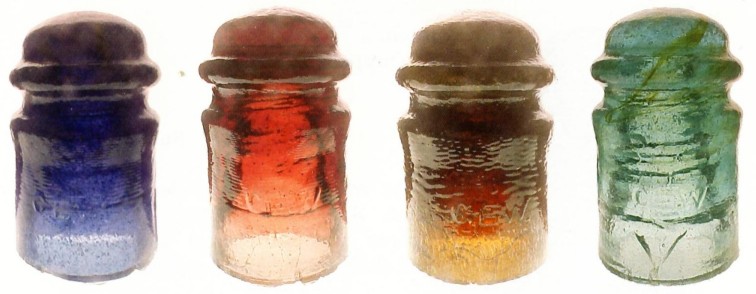
WILD THINGS
About ten years ago a number of glass objects purported to be CD 120 C.E.W.'s
came onto the insulator market. Beyond the wild colors of some (not all), there
are a number of other problems with them. Here's how to recognize one. The
diameter is smaller than a genuine C.E.W. That makes the object look taller and
skinnier, and gives an exaggerated concave appearance to the skirt. The
embossing is weak (although the embossing can be weak on a genuine insulator,
too). The glass has a "new" appearance. The surface of the glass is
shiny and wavy. There really is a reason why they look like they just came out
of a mold.
CREDITS
Insulators shown in this article are owned by Bob Jackson, Ross Baird, Mike
Green, David Campbell, Janet Bond, and Howard Banks. Photographs were taken by
Janet Bond, Carol McDougald and Howard Banks.
Thanks to Tommy Bolack for his grant for color printing in Crown Jewels.
REFERENCES
1. A History & Guide to North American Glass Pintype Insulators, by John
& Carol McDougald, 1990.
2. Railroads of Nevada & Eastern California, Vol. 1, by David Myrick,
1962.
3. reference.insulators.com/patents by Elton Gish, Jack Tod & Bill Meier.
4. Written documentation provided to Mike Green by "Ruthie", the
granddaughter of Arthur Bell.
5. Insulators Price Guide, by John & Carol McDougald, 2003.
| 